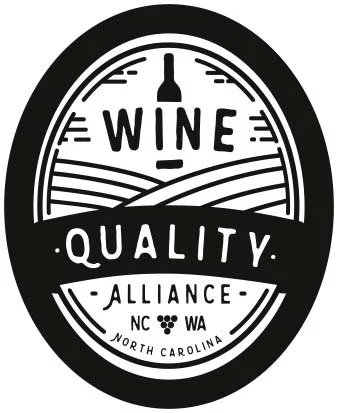About the Quality Alliance Program
The QAP Program
The North Carolina Wine Quality Alliance program is an industry-led collaboration between the North Carolina Winegrowers’ Association (NCWA) and the Viticulture and Enology Program at Surry Community College. The mission of the QAP program is to ensure the commercial viability of North Caroline Wines by providing a voluntary, objective screening system to establish standards of consistency and quality for commercial North Carolina wines. Wines submitted pass a rigorous laboratory testing and trained sensory panel screening for faults and defects that occur commonly in grape and wine production.
What are Faults?
A wine fault is an aroma, flavor, or other chemical compound that makes the wine undrinkable. Wine faults typically are the result of poor grape quality or issues during wine production. Viticulturists and Winemakers do their best to produce wines that are fault-free but sometimes these faults can slip through their own rigorous quality standards. Our program measures the content of each of these specific types of faults against the quality standards set for the wines that are made here in North Carolina.
Our program measures analytically and sensorily a variety of faults that can occur in wine.
Faults We Analyze
Volatile Acidity:
All wines want to become vinegar if you let them. Known as Volatile Acidity in the wine industry, and mostly consisting of acetic acid (also known as vinegar). VA can develop on the grapes, during fermentation, or accumulate during barrel aging. Volatile Acidity can be perceived as an aroma or flavor and have sensory characteristics like sourness, vinegar, dill pickles, nail polish remover, or soap.
Oxidation:
While important, wines and oxygen are not always the best of friends. In certain situations, oxygen can become an important component in the aging of wines. But in others, oxygen can be detrimental to wine quality, imparting flavors and aromas like sherry, cut grass, bruised apples, or an out-of-place nuttiness.
Sulfur-based off aromas:
Many aromas in wine are based chemically with sulfur. Depending on wine processing and aging methods, these sulfur-based aromas can develop negatively creating aromas and flavors of rotten or cooked vegetables, garlic, onions, burnt rubber, canned corn, or stagnant water.
Cork Taint:
The use of chlorine as a chemical sanitizer has been phased out of the wine industry over the years due to the impact it has in creating TCA. This fault can become apparent when opening a bottle of wine and is noticeable at very low levels and it is commonly associated with natural cork. TCA or 2,4,6-Trichloroanisole has distinct aromas of musty, moldy, wet cardboard, wet dog, dirty, earthy, and damp basement.
Microbial Faults:
Wine is made through the use of a microorganism called Saccharomyces cerevisiae — which converts sugars to alcohol. There are other microorganisms that are not so beneficial to the winemaking process and can create faults. These aroma faults are caused by wild yeasts and bacteria and can create cloudiness and sediment in wine, as well as aromas and flavors like milkiness, cheesiness, or rancid butter.
Our Process
When samples are received by the SCC quality lab, they are processed in our laboratory against program standards for these faults. If no faults are present, wines then are transferred to a trained sensory panel that assess the wine for those faults. At SCC, we train a group of wine and winemaking professionals to sense these particular faults at low levels in the wine. This is an added level of quality assurance and maintains a basic standard of quality amongst all QAP-certified wines. If the wines submitted pass our rigorous laboratory and human testing, they are then certified by the program. If wines do not pass our panel, our SCC lab will contact the winery with the faulted wine to mediate the fault. Wines can be re-submitted and will again attempt for QAP certification.
Our Goals
The goals of the QAP program are two-fold. First, in the long term, the QAP program aims to increase wine quality throughout the state through education at industry events and at Surry Community College, through faults training exercises, and overall quality awareness in grape growing and wine making production. And second, the QAP aims to increase the consumer perception of North Carolina wines by connecting our seal of quality with the certification process.
Member Wineries
Addison Farms Vineyard http://www.addisonfarms.net/
Childress Vineyards http://www.childressvineyards.com/
Daveste Vineyards https://www.davestevineyards.com/
Divine Llama Vineyards https://www.divinellamavineyards.com/
Elkin Creek Vineyard https://www.elkincreekvineyard.com/
Flint Hill Vineyards https://flinthillvineyards.com/
Grove Winery http://www.grovewinery.com/
Haze Gray Vineyards
pleb urban Winery http://www.pleburbanwinery.com/
Round Peak Vineyards https://www.roundpeak.com/
Raylen VIneyards https://www.raylenvineyards.com/
Shadow Springs Vineyard http://www.shadowspringsvineyard.com
Surry Cellars http://ncviticulturecenter.surry.edu/surry-cellars
Windsor Run Cellars https://www.windsorrun.com/

